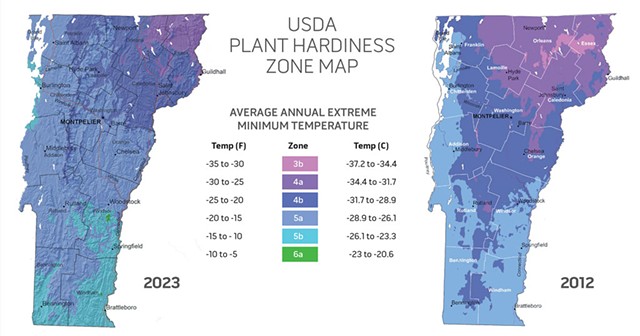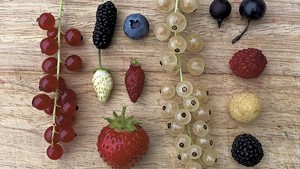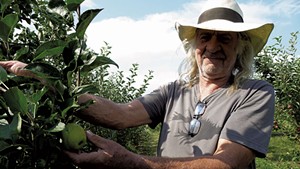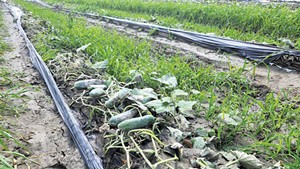
- Source: U.S. Department Of Agriculture
As home gardeners leaf through colorful seed catalogs, dreaming of this summer's edible bounty, farmers are already starting seeds in greenhouses across the state. Many are undoubtedly hoping for a strong season after last year's devastating May frost and record-setting rain.
Despite unseasonably warm recent temperatures, Vermonters know there are still months to go before the "safe" outdoor planting date of Memorial Day weekend. And this year, as gardeners plan, they might want to take a closer look at the hardiness zones on their seed packets.
In November, the U.S. Department of Agriculture released its first updated Plant Hardiness Zone Map since 2012. The map — which divides the country into zones ranging from 1a to 13b, coldest to warmest — has long served as a guide for overwintering plant tolerance and when to plant in the spring. It does so based on average annual minimum winter temperature data.
The latest map confirms a warming trend that Vermont gardeners and farmers have been experiencing firsthand for years. The update shows a dramatic shift across the state, with the bulk of central Vermont warming from zone 4b (minimum of -25 to -20 degrees) to 5a (minimum of -20 to -15 degrees). Parts of the Burlington area have bumped up from 5a to 5b (minimum of -15 to -10 degrees). Zone 3b (minimum of -35 to -30 degrees) has disappeared from the Northeast Kingdom, and Vermont now registers zone 6a (minimum of -10 to -5 degrees) for the first time in a few spots in Windham and Windsor counties.
For Kevin and Paula Dougherty of Rochester's Uphill Farm, the new map is no surprise. Their small farm market and community-supported agriculture operation sells plants, vegetables, herbs, flowers and berries. The USDA has affirmed significant changes the couple have observed over four decades of farming in central Vermont.
"Grapes were something nobody ever would seriously consider growing in this area, and now we do," Kevin said. "Blueberries were ... kind of iffy. Raspberries, the same. The canes would die, but we haven't seen that in years."
That doesn't mean Vermont has become the Golden State. "When we sell plants in the spring, people look for things like Big Boy tomatoes," Kevin said. "[Big Boy] are California tomatoes. We won't touch 'em." They prefer to stick with tried-and-true varieties.
Andy Jones, who has managed the 600-plus-member Intervale Community Farm's CSA operation in Burlington since 1993, said the season there has lengthened considerably over three decades of farming.
"We are consistently into the field earlier than we were in the early '90s," he said.
Some spring crops such as lettuce and spinach are now ready to harvest by early June. Frost-tender crops like squash, tomatoes and peppers are being planted outdoors earlier, and hardy fall crops such as kale and Brussels sprouts may be harvestable into December.
"There are a few things that we didn't even consider planting [in the past], like sweet potatoes," Jones said. Crops such as okra, certain eggplant varieties and even ginger are increasingly common in the state, he noted.
On the flip side, some plants are trickier.
"We have had a harder time growing a lot more cool-season crops through the summer," Jones said. Examples include head lettuce, broccoli and spinach, which suffer from the consistently higher peak summer temperatures.
While commercial operations must carefully weigh risks, Jones encouraged home gardeners to experiment, particularly with annual crops. "If you have a little bit of space, you don't have a lot to lose," he said. "You might as well push the envelope, because sometimes things will work out."








Comments
Comments are closed.
From 2014-2020, Seven Days allowed readers to comment on all stories posted on our website. While we've appreciated the suggestions and insights, right now Seven Days is prioritizing our core mission — producing high-quality, responsible local journalism — over moderating online debates between readers.
To criticize, correct or praise our reporting, please send us a letter to the editor or send us a tip. We’ll check it out and report the results.
Online comments may return when we have better tech tools for managing them. Thanks for reading.